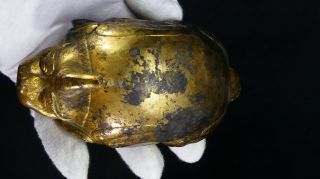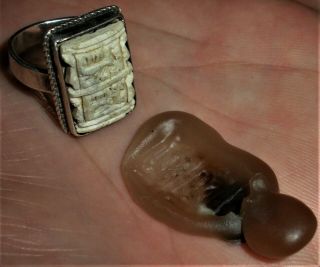2, 000 Year - Old Chinese Gilt - Bronze Pig Dragon Floor Mat Weight Year Of The Pig
Item History & Price
| Reference Number: Avaluer:71102 | Type: Floor Mat Weight |
| Primary Material: Gilt-Bronze | Region of Origin: China |
| Original/Reproduction: Antique Original | Age: 206 BC--220 AD |
| Color: Gold |
Ancient CivilizationsAntiques, Artifacts & Fine Collectibles
Ancient Chinese Gilt-Bronze Pig Dragon
Ancient Imperial Floor Mat WeightA Bronze Menagerie from the Han Dynasty
206 BC--220 AD
Thislisting is for for a RARE, gilt-bronze Floor Mat Weight in the shape of a Pig Dragon that dates to approximatelythe Han Dynasty (206 BC--220 AD).
This gilt-bronze mat weight likely belonged to a very powerful Mandarin or Marquis in ancient Chi...na's imperial court, asnearly all bronze personal items from that time period were not gilded.
It is Guaranteed Original and Authentic with no repairs or restorations--a Museum Quality piece!
This gilt-bronze Dragon weight has an auction appraisal estimate of $15, 000--$20, 000 USD!!
DETAILSThisstunning and Extremely RARE Chinese, gilt-bronze mat weight—in the shape of a Pig/BoarDragon—dates to the Han Dynasty (206 BC—220 AD) and it is remarkable for itslarge size and particularly bold and dynamic arrangement that features a singlehorn in the center of his head. Thiscast, gilt-bronze Pig Dragon weighs 12.3 oz. (349 gr.) and measuresapproximately 4.65” long x 2.66” wide x 2.60” tall (118 mm x 68 mm x 66 mm). ThisPig Dragon has a single horn in the center of his head—a common attribute inearly dragons before they were depicted with two horns centuries later. Cast in bronze and then coated with gold, thehollow dragon has a nice, blue-green patina from the oxidized bronze on theinside. Outside, he still retainsapproximately 80% of its applied gold finish, while some bronze areas show alovely patina of greenish-blue bronze oxidation.Themajority of known, bronze mat weights measure approximately three inches orless in length; however, a small number of larger weights, like this examplethat measures about 4.65” long, are on display in the world’s finest museums. TheMET has a superb collection of gilt-bronze mat weight that were used during theHan Dynasty.REF: Four Western Han dynasty bears, eachmeasuring between 5” and 6.25” from the collections of the Isabella StewartGardner Museum, Boston; The Cleveland Museum of Art and the Saint Louis ArtMuseum were included in the exhibition “A Bronze Menagerie: Mat Weights of Early China, ” IsabellaStewart Gardner Museum, Boston, 2007, cat. Nos. 4-6. HistoricalContextTheimage of a mythical, horned, pig-dragon beast has been a popular image inChinese art since antiquity. In ancient HanChina about 2, 000 years-ago, people customarily sat on woven mats on the floorof their homes. Sculpted weights, likethis fine example, were placed at the corners of the floor mat to keep theedges from curling and as a luxurious decoration and display of aristocratic rank.Duringthe Han Dynasty, the indoor floors of houses and temples were generally coveredwith woven mats that were kept in place with weights in the shape of singleanimals, such as this fighting beast. Conceivedas functional objects to hold down domestic furnishings, such as the corners ofthe large bamboo mats used as floor coverings for either seating or for theboard game known as liubo, these bronzeweights were produced in sets of four and were also interred in tombs for use bythe elite aristocrats in the afterlife.Matweights crafted from precious materials such as bronze and jade, and oftengilded or inlaid with gold, silver or gemstones, represent the pinnacle ofcraftsmanship during the Warring States period (475-221 BC) and Han dynasty(206 BC - AD 220). Conceived as functional objects to hold downdomestic furnishings, such as the corners of mats used either for seating orfor the board game known as “liubo, ”weights were produced in sets of four, and were also interred for use in theafterlife. Thisstunning example would have been made for a very wealthy member of the imperialclass. A low bed, small table, privacyscreen, and mats were often the only furnishings in an average HanDynasty room. Although any family that could afford theimmense luxury of gilt-bronze mat weights, surely had to be from the upperclass.
Bronze Mercury Gilding/Silvering in Ancient ChinaAfter this bronze mat weight was cast in mold about 2, 000years ago, it was coated with an amalgam of mercury and a gold. Mercury is a metal that is liquid at roomtemperature. When combined with gold or silver, it becomes viscous, itsconsistency becoming similar to that of butter. Mercury gilding is the process in whichmercury is mixed with gold to make an amalgam that is applied to the surface ofan object. When the Pig Dragon was heated in an oven or over a fire, the mercury evaporates and leaves behind a thin coating of gold or silver. Mercury-gilded/silvered objects must be firedat very high temperatures in order to evaporate the mercury, which boils at 357degrees Celsius. The evaporation processresults in bubble-shaped cavities forming within the coating, requiring a finalburnishing step to make it smooth.Mercury gilding was invented in China around the fifthcentury B.C.E. Gold powder and mercurywere mixed together to form a paste (also called an amalgam). The paste wasapplied to bronze or silver surfaces and heated. The mercury would vaporizewith heat, leaving a thin layer of gold that was then burnished to give asmooth, shiny, gilded surface. Before electroplating was invented, mercury amalgams werethe best choice for producing a smooth, thick coating of gold or silver on athree-dimensional object. The process also had the advantage of being able tobe repeated until a coating of the desirable thickness was achieved. However, mercury gilding/silvering is rarelyperformed today due to its toxicity: when mercury evaporates during the heatingprocess harmful vapors are released. Infact, this technique is illegal in many countries.REF: Philadelphia Museum of Art web page
Symbolismof the Wild Boar/Pig in Ancient ChinaInancient China, the wild boar and pig were symbolic of bravery. Not only did the ancient people raise pigs intheir houses, but their social activities were also centered on the issuesrelated to the pigs. For example, interms of the font style, the ancient Chinese character (referring to theinscriptions on bones or tortoise shells) "事"depicts a man catching a pig with a long handle in his hand. What'smore, the quality of men was also measured by the pig (actually the wild boar)hunting activity in ancient times. Forexample, in terms of the font style, the ancient Chinese character "敢" depicts a man catching a pigwith his bare hands. As a result, theChinese character "敢"means bravery, and those who couldn't catch a pig were considered to be cowardsin ancient times.Inmodern times, the pig seems a docile animal due to having lost its originalnature after being isolated from nature and tamed for such a long time. While in ancient China, the wild boar was a veryviolent beast that was capable of violent attack if cornered; therefore, in theancient Chinese culture, the pig symbolizes marching fearlessly onward againstone’s enemies. PROVENANCEThisgilt-bronze mat weight was purchase from a private collection in Beijing and iscurrently in a private collection in the State of Washington. This is the first time it is being offeredfor sale in the United States. REFERENCES:1. WilliamWatson, Ancient Chinese Bronzes, London, 1962, pl. 84, fig. c.2. HayashiMinao and Higuchi Takayasu, Fugendō Sakamoto Gorō Chūgoku seidōkiseishō / Ancient Chinese Bronzes in the Sakamoto Collection, Tokyo, 2002, col. pl. 16.3. Sotheby’sChinese Sale, 19 March 20134. Sotheby’sAuction, 13 September 20165. “A Bronze Menagerie: Mat Weights ofEarly China”exhibit at the Isabella Stewart Gardner Museum, Boston, 2007, cat. nos4-6. 6. Collectionof the Cleveland Museum of Art7. Collectionof the Saint Louis Art Museum CONDITIONThis gilt-bronze Pig Dragon Weight has authenticred and blue-green oxidation form the bronze that was buried for millennia indamp soil that was rich in cuprite, azurite, and malachite. It is in “as found” condition and has been ina private collection in China for decades. Museums and modern archeological studiesusually use the general term “copper alloy” instead of just the term “bronze”to describe these ancient treasures, as many other elements (such as tin, lead, zinc, iron, and even arsenic) were added to the copper to form differentstrengths of types of bronze items. Ancient bronze artifacts such as this seals are probably about 80%copper and 20% tin, while modern bronze is closer to 88% copper and 12% tin.It has a wonderful old, patina that isabsolutely fabulous: areas of a blue-green patina from the azurite andmalachite in the surrounding soil. This combination of colors forms a fantasticpatina that is typical of bronze that has been buried for over 1, 000years. Close examination with amicroscope under natural and black light reveal it to be 100% authentic andcast by hand in a sand mold.One interesting property of bronze is thatonce it has oxidized superficially, a copper oxide layer is formed on thesurface and essentially protects the object from further damagingcorrosion. This protective layer turnsin another compound, called copper carbonate for you scientists out there, which protects most bronze pieces from further corrosion. I have carefully examined this item undermagnification and it shows authentic and original signs of weathering andground contact that help to further authenticate it as an ancient piece. It shows minor oxidation and is in very goodcondition. I Guarantee this gilt-bronze Pig Dragon is authentic or your money back! You willnot be disappointed!
It is a museumquality, ancient Chinese work of art with wonderful, historical significance. It is a wonderful piece and would look greatdisplayed next to your other fine ancient Chinese jade and bronze pieces! ESTIMATEDAUCTION VALUE & SAVINGSThis gilt-bronze, Dragon mat weight has an appraisal estimate of US $15, 000--$20, 000.
Please examine the photos taken at 4x macro carefully as they are part of the description. The stand and the ruler are not included in this auction, just there to help you better judge the size.





























